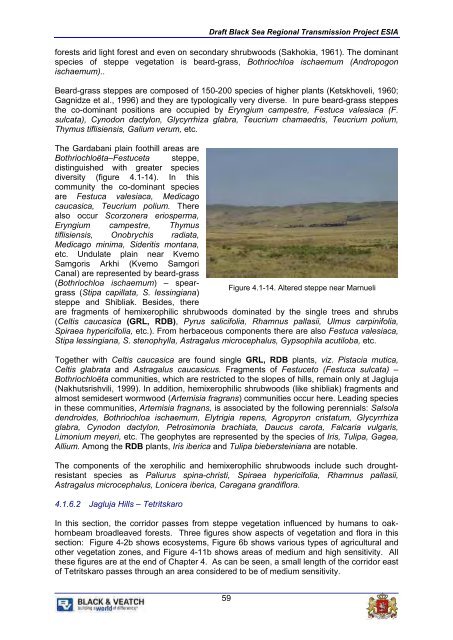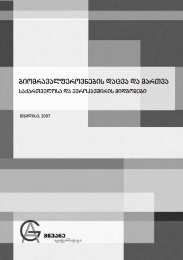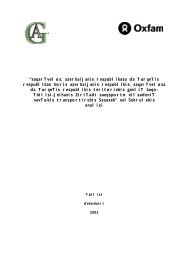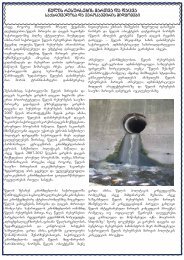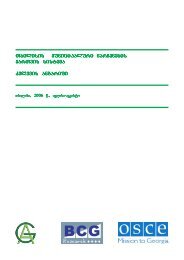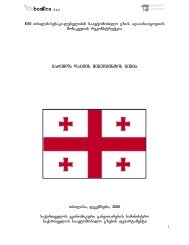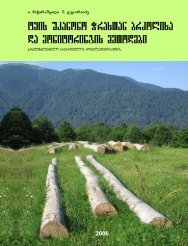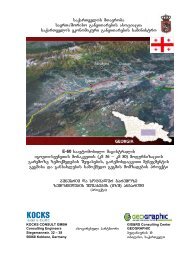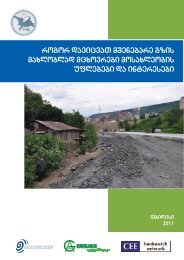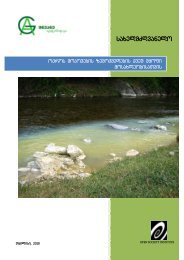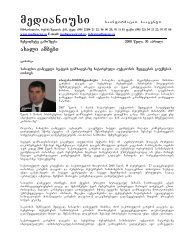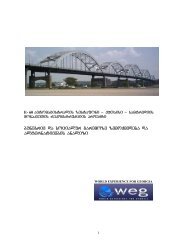Part I
Part I
Part I
You also want an ePaper? Increase the reach of your titles
YUMPU automatically turns print PDFs into web optimized ePapers that Google loves.
Draft Black Sea Regional Transmission Project ESIA<br />
forests arid light forest and even on secondary shrubwoods (Sakhokia, 1961). The dominant<br />
species of steppe vegetation is beard-grass, Bothriochloa ischaemum (Andropogon<br />
ischaemum)..<br />
Beard-grass steppes are composed of 150-200 species of higher plants (Ketskhoveli, 1960;<br />
Gagnidze et al., 1996) and they are typologically very diverse. In pure beard-grass steppes<br />
the co-dominant positions are occupied by Eryngium campestre, Festuca valesiaca (F.<br />
sulcata), Cynodon dactylon, Glycyrrhiza glabra, Teucrium chamaedris, Teucrium polium,<br />
Thymus tiflisiensis, Galium verum, etc.<br />
The Gardabani plain foothill areas are<br />
Bothriochlota–Festuceta steppe,<br />
distinguished with greater species<br />
diversity (figure 4.1-14). In this<br />
community the co-dominant species<br />
are Festuca valesiaca, Medicago<br />
caucasica, Teucrium polium. There<br />
also occur Scorzonera eriosperma,<br />
Eryngium campestre, Thymus<br />
tiflisiensis, Onobrychis radiata,<br />
Medicago minima, Sideritis montana,<br />
etc. Undulate plain near Kvemo<br />
Samgoris Arkhi (Kvemo Samgori<br />
Canal) are represented by beard-grass<br />
(Bothriochloa ischaemum) – speargrass<br />
(Stipa capillata, S. lessingiana)<br />
Figure 4.1-14. Altered steppe near Marnueli<br />
steppe and Shibliak. Besides, there<br />
are fragments of hemixerophilic shrubwoods dominated by the single trees and shrubs<br />
(Celtis caucasica (GRL, RDB), Pyrus salicifolia, Rhamnus pallasii, Ulmus carpinifolia,<br />
Spiraea hypericifolia, etc.). From herbaceous components there are also Festuca valesiaca,<br />
Stipa lessingiana, S. stenophylla, Astragalus microcephalus, Gypsophila acutiloba, etc.<br />
Together with Celtis caucasica are found single GRL, RDB plants, viz. Pistacia mutica,<br />
Celtis glabrata and Astragalus caucasicus. Fragments of Festuceto (Festuca sulcata) –<br />
Bothriochlota communities, which are restricted to the slopes of hills, remain only at Jagluja<br />
(Nakhutsrishvili, 1999). In addition, hemixerophilic shrubwoods (like shibliak) fragments and<br />
almost semidesert wormwood (Artemisia fragrans) communities occur here. Leading species<br />
in these communities, Artemisia fragnans, is associated by the following perennials: Salsola<br />
dendroides, Bothriochloa ischaemum, Elytrigia repens, Agropyron cristatum, Glycyrrhiza<br />
glabra, Cynodon dactylon, Petrosimonia brachiata, Daucus carota, Falcaria vulgaris,<br />
Limonium meyeri, etc. The geophytes are represented by the species of Iris, Tulipa, Gagea,<br />
Allium. Among the RDB plants, Iris iberica and Tulipa biebersteiniana are notable.<br />
The components of the xerophilic and hemixerophilic shrubwoods include such droughtresistant<br />
species as Paliurus spina-christi, Spiraea hypericifolia, Rhamnus pallasii,<br />
Astragalus microcephalus, Lonicera iberica, Caragana grandiflora.<br />
4.1.6.2 Jagluja Hills – Tetritskaro<br />
In this section, the corridor passes from steppe vegetation influenced by humans to oakhornbeam<br />
broadleaved forests. Three figures show aspects of vegetation and flora in this<br />
section: Figure 4-2b shows ecosystems, Figure 6b shows various types of agricultural and<br />
other vegetation zones, and Figure 4-11b shows areas of medium and high sensitivity. All<br />
these figures are at the end of Chapter 4. As can be seen, a small length of the corridor east<br />
of Tetritskaro passes through an area considered to be of medium sensitivity.<br />
59


